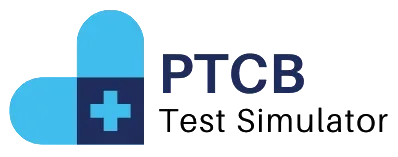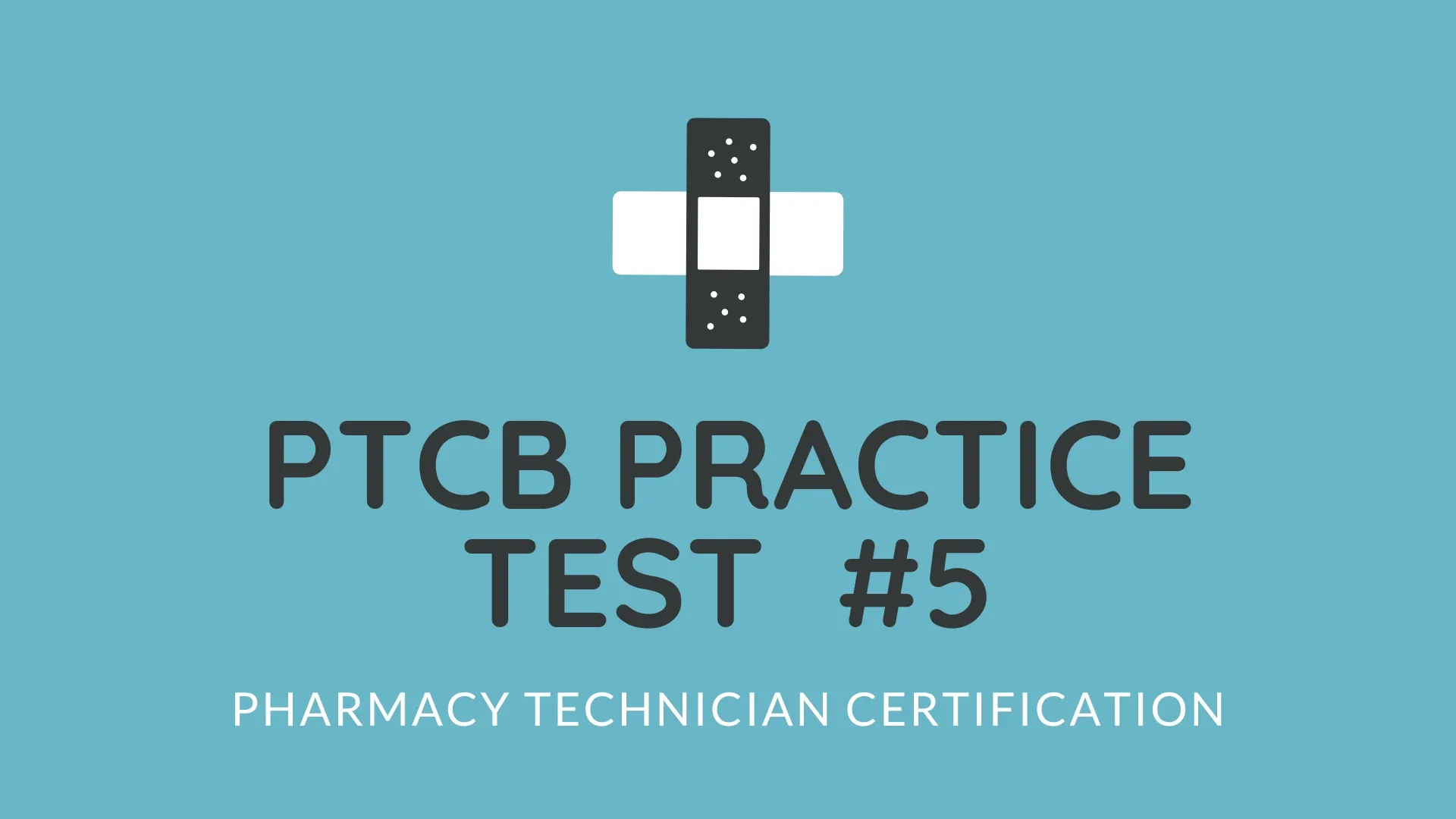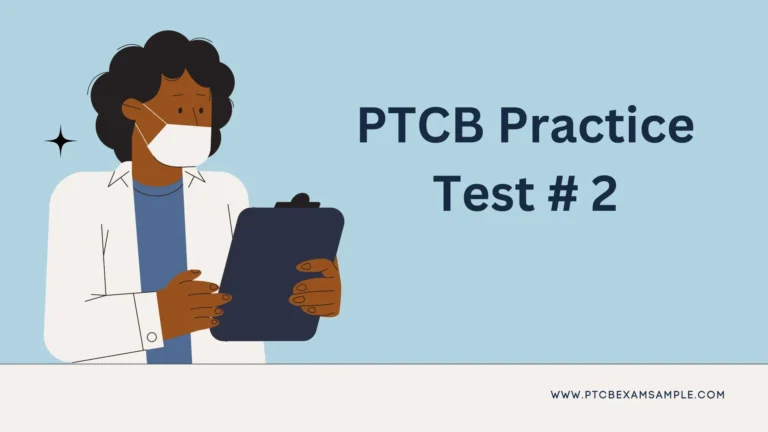Practice Test 5
The PTCB Exam Sample for Pharmacy Technicians is a pivotal step for those pursuing a career in pharmacy technology. To succeed, candidates must demonstrate proficiency in a range of subjects, including pharmacology, pharmacy law, medication safety, and pharmaceutical calculations. This Sample 5 provides a set of practice questions designed to help you prepare for the exam. By engaging with these questions, you’ll gain a better understanding of the key concepts tested in the PTCB exam and improve your chances of success.
Try More Practice Tests
Understanding the Scope of the PTCB Exam
The PTCB exam assesses the knowledge and skills required for pharmacy technicians. It covers topics such as:
- Pharmacology: Understanding drug classes, mechanisms of action, indications, and side effects.
- Pharmacy Law: Knowledge of federal regulations, controlled substances, and pharmacy practice standards.
- Medication Safety: Familiarity with best practices for preventing medication errors and ensuring patient safety.
- Pharmacy Calculations: Ability to perform dosage calculations, unit conversions, and other mathematical operations.
PTCB Exam Sample for Pharmacy Technician
The following Exam Sample 5 presents practice questions across various topics. Use these questions to test your knowledge and identify areas for further study.
Pharmacology Questions
Pharmacology is a core component of the exam. It involves understanding the therapeutic uses of medications and the potential side effects. Let’s start with a few pharmacology-related questions.
Question 1: Common Drug Indications
Which of the following medications is commonly used to treat high blood pressure? A) Amlodipine B) Atorvastatin C) Sertraline D) Metformin
Answer: A) Amlodipine
Explanation: Amlodipine is a calcium channel blocker commonly prescribed to treat high blood pressure (hypertension). It helps relax blood vessels, reducing blood pressure. Knowing drug indications is essential for the PTCB exam.
Question 2: Mechanisms of Action
How does acetaminophen exert its analgesic (pain-relieving) effect? A) Inhibition of cyclooxygenase (COX) enzymes B) Blockade of opioid receptors C) Stimulation of serotonin receptors D) Activation of cannabinoid receptors
Answer: A) Inhibition of cyclooxygenase (COX) enzymes
Explanation: Acetaminophen works by inhibiting cyclooxygenase enzymes in the central nervous system, reducing the production of prostaglandins, which cause pain and inflammation. Understanding mechanisms of action is crucial for the exam.
Pharmacy Law and Regulations
Pharmacy law encompasses various federal regulations and standards governing pharmacy practice. It’s important to understand these laws to ensure compliance and patient safety.
Question 3: Controlled Substances Regulation
What is the role of the Drug Enforcement Administration (DEA) in pharmacy practice? A) Regulate controlled substances B) Approve new drugs for market C) Monitor patient health information D) Enforce state pharmacy laws
Answer: A) Regulate controlled substances
Explanation: The DEA is responsible for regulating controlled substances, including scheduling, registration, and compliance. Pharmacy technicians must understand DEA regulations for the PTCB exam.
Question 4: HIPAA Compliance
What does the Health Insurance Portability and Accountability Act (HIPAA) govern? A) Protection of patient health information B) Regulation of controlled substances C) Prescription drug pricing D) Approval of new medications
Answer: A) Protection of patient health information
Explanation: HIPAA establishes standards for protecting patient health information and ensuring privacy and confidentiality. Knowledge of HIPAA compliance is critical for the PTCB test.
Medication Safety and Drug Interactions
Medication safety is a significant focus of pharmacy practice. Pharmacy technicians must be aware of common medication errors and drug interactions to ensure patient safety.
Question 5: Preventing Medication Errors
Which of the following practices helps prevent medication errors in a pharmacy setting? A) Double-checking prescriptions B) Using automated dispensing systems C) Conducting drug utilization reviews D) All of the above
Answer: D) All of the above
Explanation: Preventing medication errors requires a multifaceted approach. Double-checking prescriptions, using automated systems, and conducting drug utilization reviews are all effective practices for reducing errors. These are important concepts for the exam.
Question 6: Common Drug Interactions
Which of the following is a potential drug interaction with warfarin? A) Increased risk of bleeding with aspirin B) Decreased effectiveness with vitamin K C) Both A and B D) None of the above
Answer: C) Both A and B
Explanation: Warfarin has a high risk of drug interactions. Aspirin increases the risk of bleeding, while vitamin K can reduce warfarin’s effectiveness. Pharmacy technicians must understand common drug interactions for the PTCB exam.
Pharmacy Calculations
Pharmacy calculations are a critical part of the exam. These questions test your ability to perform basic arithmetic, dosage calculations, and unit conversions.
Question 7: Dosage Calculation
A prescription requires 500 mg of a medication. If you have 250 mg tablets, how many tablets should be dispensed? A) 1 tablet B) 2 tablets C) 3 tablets D) 4 tablets
Answer: B) 2 tablets
Explanation: To determine the number of tablets to dispense, divide the required dose by the available strength. In this case, the required dose is 500 mg, and the available strength is 250 mg per tablet. Thus, 500 mg ÷ 250 mg/tablet = 2 tablets.
Question 8: IV Flow Rate Calculation
An IV bag contains 1,000 milliliters (mL) and needs to be infused over 5 hours. What is the flow rate in milliliters per hour (mL/hr)? A) 200 mL/hr B) 250 mL/hr C) 300 mL/hr D) 150 mL/hr
Answer: A) 200 mL/hr
Explanation: To calculate the flow rate, divide the total volume by the total time in hours. Here, the total volume is 1,000 mL, and the total time is 5 hours. Thus, 1,000 mL ÷ 5 hours = 200 mL/hr.
Tips for Succeeding in the PTCB Exam
To excel in the PTCB test, consider the following tips:
- Practice Regularly: Regular practice with quizzes and sample tests helps reinforce your knowledge and build confidence. Use this PTCB Exam Sample 5 to assess your understanding.
- Understand the Basics: Ensure you have a solid grasp of the fundamental concepts in pharmacology, pharmacy law, medication safety, and pharmacy calculations.
- Use Study Guides and Resources: Utilize study guides and online resources specifically designed for the exam to improve your skills and cover all required topics.
- Join Study Groups: Study groups and online forums are excellent resources for discussing challenging topics and sharing study tips with peers preparing for the test.
- Seek Guidance from Pharmacists: If possible, seek advice from experienced pharmacists or pharmacy technicians to gain insights into real-world scenarios and best practices in pharmacy.
By following these tips and practicing regularly with quizzes like this PTCB Exam Sample 5, you’ll be well-prepared for the PTCB exam and better equipped for your role as a certified pharmacy technician.
Conclusion
The test exam covers a broad range of topics, from pharmacology and pharmacy law to medication safety and pharmacy calculations. This PTCB Exam Sample 5 provides a comprehensive set of practice questions to help you prepare for the exam. By focusing on these topics and practicing regularly, you’ll increase your chances of success on the exam and ensure a solid foundation for your pharmacy technician career. Good luck with your studies and your journey toward certification!



